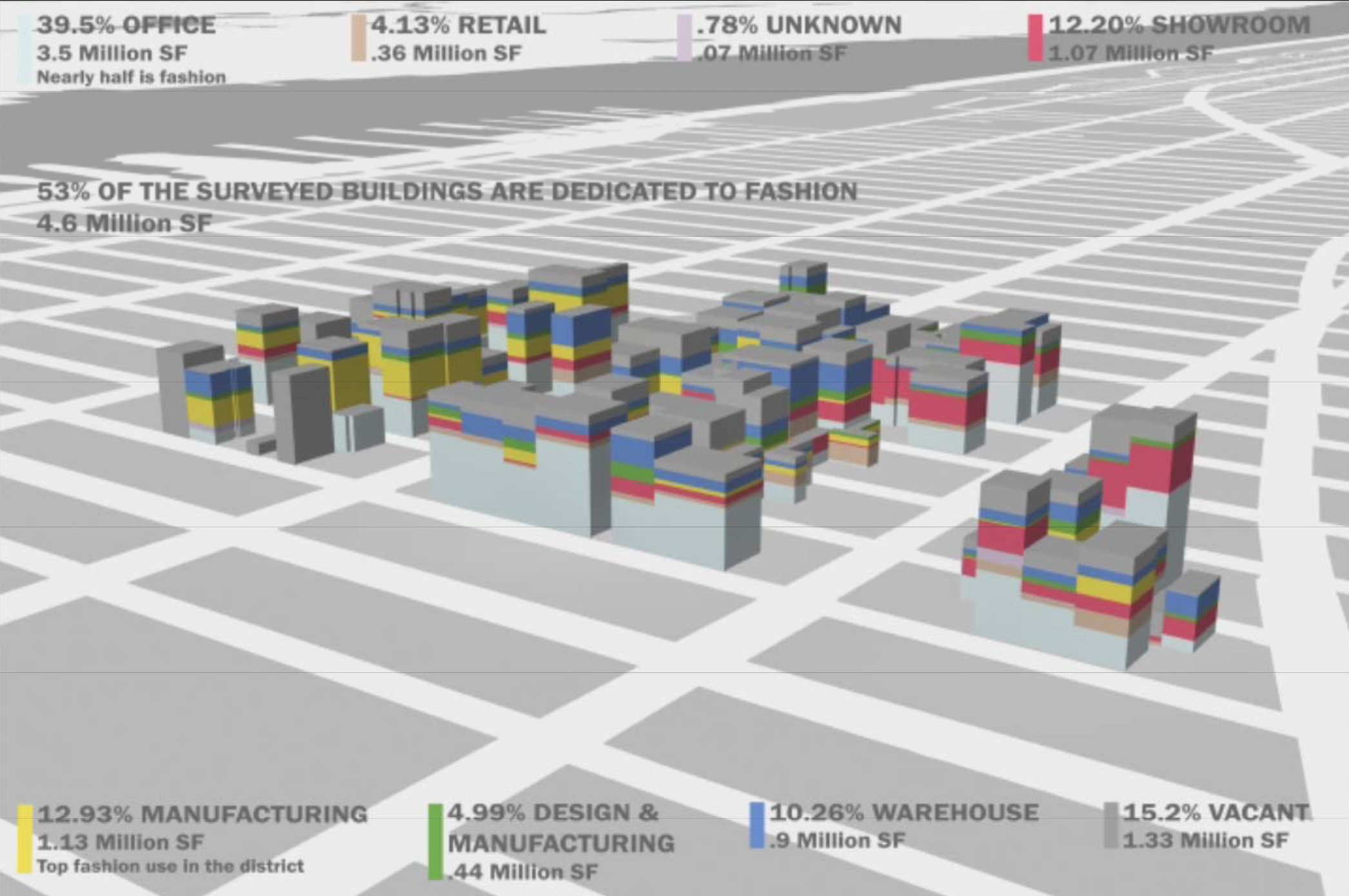Made In Midtown
2009-2010
︎︎︎ Project Website
Project Lead
Sarah Williams
Project Manager
Minna Niova
Research Assistants
Brian Brush
Georgia Bullen
Kyu-won Lee
Support from
Design Trust for Public Space
︎︎︎ Project Website
Project Lead
Sarah Williams
Project Manager
Minna Niova
Research Assistants
Brian Brush
Georgia Bullen
Kyu-won Lee
Support from
Design Trust for Public Space
Overview
From factories to runways, showrooms to sample sales, fashion is woven into New York City's cultural DNA. The heart of the industry is in the Garment District, the cluster of blocks spanning 34th to 40th Streets between Broadway and Ninth Avenue. Today's Garment District is a world leader in innovation, home to an extensive network of designers, manufacturers, and suppliers that provide a neighborhood-wide incubator for emerging design talent and a source of working- and middle-class jobs, all in the heart of Midtown Manhattan.
In Fall 2009, Sarah Williams and the the Spatial Innovation Design Lab were awarded a fellowship for Made In Midtown, a collaborative research project initiated by the Design Trust for Public Space and the Council for Fashion Designers of America (CFDA). Inspired by news that New York City was considering a proposal to change the protected manufacturing zones of the Garment District, the project sought to understand how the garment industry works and how it contributes to New York City’s economy, identity, and sense of place.
Working alongside urban designers, graphic designers, a filmmaker, and a journalist, the team analyzed more than two decades of industry data in order to understand how changes to the Garment District would affect the industry, the neighborhood and the City. By mapping the fashion industry ecosystem – its trends, processes, and component parts – the team was able to contribute to the creation of a compelling story about the Garment District’s past, present and future.
Making Midtown 1916-2010
 The Birth of Zoning
The Birth of ZoningNew York’s garment industry is gradually squeezed out of lower Manhattan because of rising rents and proprietors of garment factories come to informal agreements to concentrate the garment production to the west of the upscale shopping districts in midtown Manhattan.
 Refining the Code
Refining the CodeIn response the the wave of new buildings and businesses that followed the 1961 zoning resolution, New York City establishes special zoning districts that surround the garment district.
 Redefining the CBD
Redefining the CBDThe creation of the Midtown Special purpose district and the 42nd Street Development project had the Federation of Apparel Manufacturers and the International Ladies Garment Workers Union concerned about rising rents and job displacement of garment workers.
 Garment District
Garment DistrictThe Koch Administration Established the Special Garment Center District with the intention to use the land use restrictions to preserve affordable manufacturing space, protect production jobs, and allay the fear that manufacturing would be squeezed out as spaces converted to office uses.
 Growth on the West Side
Growth on the West SideNew York City opens up the Garment District’s protective zoning allowing for more more office, retail and hotels to be located in the district. This combined with the development of the Hudson Yards Special District puts concerns garment industry workers about the future of this district.
 Uncertain Future
Uncertain FutureWith manufacturing on the decline, New York City considers changing the current protections on manufacturing.
-



-
 As part of the research in the Garment District the research team developed a 3D model of the types of apparel related businesses on each building floor in the garment district. The 3D model was developed into a movie and interactive map. 53% (4.6 million sq.ft) of the buildings in the Garment District are dedicated to fashion.
As part of the research in the Garment District the research team developed a 3D model of the types of apparel related businesses on each building floor in the garment district. The 3D model was developed into a movie and interactive map. 53% (4.6 million sq.ft) of the buildings in the Garment District are dedicated to fashion. While apparel manufacturing has been on a steady decline on the region one of the few places it remains is in it’s core in the Garment District and Lower Manhattan.
While apparel manufacturing has been on a steady decline on the region one of the few places it remains is in it’s core in the Garment District and Lower Manhattan.
Publications
Williams, Sarah, and Elizabeth Currid-Halkett. “The Emergence of Los Angeles as a Fashion Hub: A Comparative Spatial Analysis of the New York and Los Angeles Fashion Industries.” Urban Studies (2011): 48:14.
Currid, Elizabeth, and Sarah Williams. “Two Cities, Five Industries: Similarities
and Differences Within and Between Cultural Industries in New York and Los Angeles.” Journal of Planning Education and Research 29, no. 3 (2010): 322-335.
Press
“Made in Midtown: Why Creative Industries Matter to NYC.” The Huffington Post, 2010.
Exhibition
Made in Midtown, Times Square Pop-Up Space, New York, NY, 2010.
Williams, Sarah, and Elizabeth Currid-Halkett. “The Emergence of Los Angeles as a Fashion Hub: A Comparative Spatial Analysis of the New York and Los Angeles Fashion Industries.” Urban Studies (2011): 48:14.
Currid, Elizabeth, and Sarah Williams. “Two Cities, Five Industries: Similarities
and Differences Within and Between Cultural Industries in New York and Los Angeles.” Journal of Planning Education and Research 29, no. 3 (2010): 322-335.
Press
“Made in Midtown: Why Creative Industries Matter to NYC.” The Huffington Post, 2010.
Exhibition
Made in Midtown, Times Square Pop-Up Space, New York, NY, 2010.
